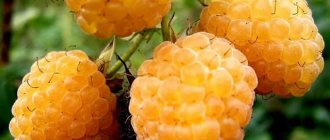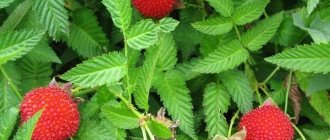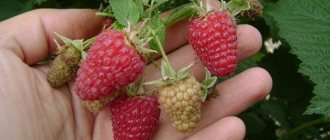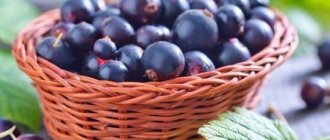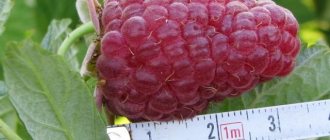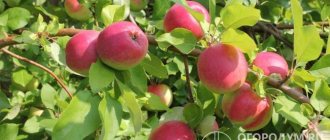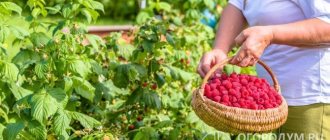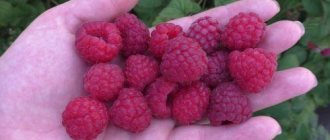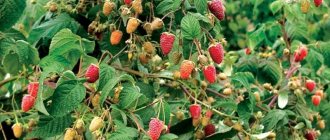Among the remontant varieties, the raspberry Daughter of Hercules occupies not the last place. The large-fruited, productive raspberry variety has become quite widespread in Russia. Large berries with pleasant taste have captivated many gardeners.
Already from the name it is clear that Daughter of Hercules was bred on the basis of the parent variety Hercules. The father and daughter varieties have a similar shape and taste of the fruit.
AGRO PREMIUM is an innovative, environmentally friendly plant activator, without chemicals, that protects berries, fruits and vegetables from pests and diseases, increases seed germination, stimulates root formation and plant growth, and significantly increases productivity.
Photo and description of raspberries Daughter of Hercules
Many gardeners know the raspberry variety Hercules. It is quite logical that the fruitful “daughter” was obtained precisely on its basis. The plant received all the best features from its “father”, and also, thanks to the efforts of breeders, the variety acquired additional advantages. All in all, we have a wonderful new variety that bears a slight resemblance to the original.
The new garden crop is a powerful shrub with stems of medium height (up to 2 meters). The bushes are quite branched and require support. The branches are thorny, like most raspberry varieties.
The Daughter of Hercules produces very few shoots, so harvesters do not have to wade through dense thickets, and gardeners have difficulty thinning out thorny bushes. During the season, only 2-4 shoots will grow, which can be easily gotten rid of if desired. Or you can make layers and share the joy with your neighbors or friends.
Bushes of this variety of raspberries will decorate any garden: during the fruiting period, a large number of bright red berries ripen on each branch. They are very large, smooth, and have dense flesh. Many experts believe that the shape of the fruits of this variety is exemplary! This is exactly what raspberries should ideally be.
Main appearance characteristics:
- stems are thick, tall;
- the berries are very large, appetizing (10-20 g);
- neat shape - a truncated cone of dark red color.
Peculiarity! It is important for novice gardeners to know that the stems of this variety of raspberries acquire a reddish tint closer to August. This is not a disease! This is the specificity of the variety.
Reviews
The raspberry variety “Daughter of Hercules” has excellent reviews from gardeners. The plant does not require special care, so it is ideal for beginners who are just starting to get acquainted with the features of growing raspberries.
The raspberry variety Daughter of Hercules is perfect for beginning gardeners.
Characteristics of the variety
Remontant raspberries are great! This means that the berries ripen continuously, until the first frost. This is exactly what our “daughter” is like – she is ready to please us until the snow:
- Fruiting is abundant, wavy.
- The productivity delights gardeners: a powerful bush brings the owner up to 10 kg per season.
- Raspberries are also unpretentious in many respects.
- The daughter of Hercules is not capricious in relation to the composition of the soil.
- Resistant to diseases.
- Tolerates difficult climatic conditions (frost, few sunny days).
- The seedlings are very tenacious and take root quickly.
- A young bush already at the end of the first year of life, closer to autumn, produces its first harvest.
Main characteristics:
- abundant fruiting from August to October;
- taste – sour;
- record yield - up to 10 kg per bush.
The taste of the berries is universal: you can eat them fresh with great pleasure, make jams, compotes, preserves, and dry them for the winter. They contain a lot of vitamin C - they can be treated for colds or other ailments.
Attention! Tolerates freezing well. If there is no time for processing at the height of the harvest, simply place the berries in the freezer.
Pros and cons of the variety - what is more?
There are no universal varieties that would satisfy the requirements of every gardener. Each plant has some disadvantages or advantages over other “competitors”. One of the biggest “disadvantages” of Hercules is the taste of the berries - they have a sourness, and it is quite noticeable even to an inexperienced gardener. In jam it is almost invisible, since it can be compensated for with sugar or the addition of other berries, but when consumed raw, not everyone likes it.
The second disadvantage is the large number of spikes. Collecting it is very inconvenient; you can easily get hurt, given the density of the shoots and their size. Summer residents try to avoid such plants, since no one needs difficulties in harvesting. Slow formation of shoots will not satisfy the requirements of those who intend to grow seedlings for sale. From one bush you can get only 2-3 stems per season, which is very little for sale, but quite enough for propagation at home.
Another disadvantage is the poor keeping quality of fruits at the stage of technical ripeness. They become very soft, almost unsuitable for transportation. To avoid this, you need to pick the berries 5-7 days in advance so that they “arrive” in boxes, then such problems will not happen. As for the “cons”, that was all, this variety doesn’t have any more.
There are, of course, many more “pluses”. One of the main ones is the large size of the fruit. On average, one berry weighs 5-6 grams, but there are specimens up to 9-10 g, it all depends on the load on the bush - the more berries and shoots, the less the fruit will weigh. Fertilizer also plays a big role.
The second advantage is resistance to diseases. Remontant raspberry Daughter of Hercules and Hercules are practically invulnerable. Diseases and insects do not attack them; one preventive treatment with a systemic insecticide or a copper-containing preparation will be enough for the entire season. Only in some regions with high air humidity and low temperatures in summer can pests create problems during cultivation, but they can also be solved with one spraying.
Another “plus” is abundant fruiting. From one bush you can collect up to 4-5 kg of berries, which is simply incredibly large for raspberries. Moreover, you will be able to harvest at a time when the season has already passed and selling the berries will be much more expensive. Remontant raspberries Daughter of Hercules and Hercules bear fruit until frost, fruit ripening by the end of November is 95%. This way, you can enjoy the goodies for much longer.
Does not require gartering on a trellis, the stems are powerful and erect. It is recommended to keep no more than 2 shoots per replacement so that the stems are extremely thick and have time to wooden normally before the onset of frost.
Advantages and disadvantages
Experts say that the ideal variety is a myth. It simply doesn't exist! What one gardener likes may not suit another. Some people don't like the taste too sweet. Others do not like sour fruits. So the raspberry variety should be chosen taking into account your own preferences! It is advisable to try the berries from the Daughter of Hercules bush in advance and decide to purchase seedlings only if you are completely satisfied with it.
The main advantage of the variety is easy care. The bushes do not need to be particularly processed or the growth removed. Raspberries rarely get sick, tolerate frost well, quickly take root and produce a rich harvest even on poor soil.
Advantages:
- easy care (no need to thin out raspberries);
- remontability of the variety;
- buyer interest (the appearance of the berries and the ability to withstand transportation makes them commercially attractive).
Flaws:
- sour taste;
- powerful spikes;
- the need to install trellises;
- late date of second fruiting.
Landing
We talked a lot about unpretentiousness. Yes, it is not demanding on the composition of the soil and tolerates frost. But miracles do not happen - like any other raspberry, the Daughter of Hercules is very dependent on the sun. In order for the berries to ripen, the raspberry plant must receive direct sunlight! And this is the basic criterion for choosing a landing site. You need to choose an area that will definitely be illuminated by the sun most of the day. If this does not happen, the harvest will be much smaller, and the taste will deteriorate significantly.
It is also important that the site is protected from drafts and strong northern winds. Wetland will not work. In such soil, the raspberry roots will rot and the bushes will die.
Planting is carried out in the following steps:
- soil preparation (selection of site, application of fertilizers);
- preparation of trenches or planting holes (depth of at least half a meter, distance between rows of at least one and a half meters);
- placing compost, manure or other fertilizers at the bottom;
- planting seedlings (at a distance of at least 0.7 m, while the root collar should be flush with the ground);
- neat distribution of roots;
- distribution of soil over the hole;
- abundant watering;
- cutting the seedling at a height of 30 cm.
Attention! Before planting, make sure that there is no groundwater running under the site you choose. The daughter of Hercules cannot tolerate excessive dampness. A place where there was already a raspberry tree before will also not work (about 5 years should pass).
Description of the remontant raspberry variety Hercules
Raspberry Hercules is a remontant variety that has large fruits. This plant is characterized by excellent taste and high yield. To achieve success in growing a crop, you need to provide it with quality care.
The history of the raspberry Hercules
Remontant raspberry Hercules was obtained in the Bryansk region. It was bred by breeder I.V. Kazakov, who worked at the Kokino Institute. The plant is the result of crossing the mid-season variety Ottom Bliz and seedling No. 14-205-4. This variety is often called Hercules.
History of the Daughter of Hercules variety
Based on this variety, its variety was obtained - raspberry Daughter of Hercules. This culture has not yet entered the State Register. The plant is characterized by the main features of the parent culture.
At the same time, the remontant raspberry Daughter of Hercules is characterized by a more spreading bush that needs high-quality support. In addition, it has larger fruits weighing 16 g.
Description and characteristics
According to the description of the variety, Hercules raspberries can be grown in Russia, Ukraine, and Belarus. The plant needs light soil with a fertile composition. In the north, the plant bears fruit worse and has less expressive taste.
The culture has spreading bushes that reach 1.5-2 m. It is characterized by powerful shoots that branch well. The plant has hard spines that are curved down. The leaves are medium in size and rich green in color.
Raspberries are resistant to frost and drought. However, in snowless winters it needs to be covered. However, it is important to remember a sense of proportion. With strong insulation there is a risk of death of the bush.
This variety is characterized by cone-shaped ruby fruits. On average, they weigh 6 g. The berries are located under the leaves, which provides them with reliable protection from birds. The fruits are characterized by a pleasant sweet and sour taste and pronounced aroma.
Important! The first fruits ripen at the end of June. The second harvest can be obtained in mid-August, and fruiting continues until frost.
Advantages and disadvantages
Culture has many advantages:
- excellent presentation of the fruit;
- high productivity;
- weak formation of shoots, which prevents the uncontrolled growth of raspberries;
- drought resistance;
- relative resistance to frost - it decreases only in snowless winters;
- ease of care;
- no need for trellises;
- good survival rate of seedlings;
- possibility of transportation over impressive distances;
- resistance to diseases and pests;
- the presence of thorns and the location of fruits under the leaves;
- absence of worms in the autumn harvest.
The disadvantages of the plant include the following:
- pronounced sourness in taste;
- difficulties with harvesting - they are caused by the presence of thorns on the shoots;
- plant requirements for heat and light;
- difficulties with reproduction - this is due to a small number of new shoots;
- long ripening period - some fruits do not have time to ripen before frost.
Landing rules
When planting a crop, you need to take into account a large number of features. This allows you to get a strong and strong plant.
Wrong choice of site often provokes the death of the plant. Raspberries should be planted in elevated, sunny places. It is desirable that they be located in the south of the site. When grown in shady places, yield parameters decrease.
Important! It is not recommended to plant raspberries in lowlands, as a lot of water accumulates there. This leads to root rot and the development of infections.
Soil preparation
The garden bed should be prepared in advance. It is recommended to do this 2-3 weeks before planting. For 1 square meter use 50 g of superphosphate, 2 buckets of humus, 30 g of potassium nitrate. After fertilizing the soil, it needs to be dug up and loosened. Recesses must be made at intervals of 1 m.
Planting seedlings
To plant a crop you need to do the following:
- Make indentations measuring 50 cm.
- Place a mixture of soil with the addition of humus, potassium sulfate and superphosphate at the bottom of the hole.
- After 3 weeks, place the seedling in the hole and straighten the roots.
- Sprinkle with soil and water the plant with water.
- Cover the trunk circle with peat or compost.
Basics of crop care
In order for the plant to develop normally, it needs to be properly cared for. In this case, certain rules must be followed.
Watering
Despite its resistance to drought, the plant is considered moisture-loving. When the soil dries quickly, the absorbent roots die. If you overwater, there is a risk of root rot. The optimal frequency of watering is once a week. However, you should not water the bushes too much.
Important! During fruit ripening, the number of waterings should be reduced. During this period, the plant requires a slight moisture deficit.
To saturate the soil with oxygen, it must be systematically loosened. This should be done after every watering or rain. The depth of loosening should not be more than 5-7 cm. Otherwise, there is a risk of damage to the roots.
Top dressing
The crop should be fed several times during the season:
- In mid-May, a solution of cow manure is added. To make it, you need to mix 500 g of fertilizer with a bucket of water.
- In July, foliar feeding is carried out. To do this, take 50 g of urea, 250 g of superphosphate, 10 g of boric acid, 70 g of potassium sulfate per bucket of water.
- At the end of August or beginning of September, it is recommended to add a mineral preparation to the tree trunk.
Trimming
Pruning should be done in late October or early November. In this case, it is necessary to remove two-year-old shoots that will no longer bear fruit. If a harsh winter is expected, all branches should be trimmed completely. In spring, you need to remove dried and broken branches.
Protection from pests and diseases
The crop practically does not suffer from gray rot and is not attacked by raspberry mites. At the same time, she may become ill with anthracnose. In this case, gray spots appear on the leaves and branches. For prevention, you need to properly organize drainage and plant raspberries in a sunny place.
Important! Of the pests, bushes most often suffer from stem gall midges. At the first signs of damage, infected fragments must be cut off and burned.
Harvesting
The culture is well stored and has good transportability. It is often grown for sale due to its excellent presentation and taste. At the same time, the fruits are rarely eaten fresh, since they are characterized by a noticeable sourness. The berries are usually used to make jam, jam, and compote.
Raspberry fruiting usually begins in July. The second harvest ripens in August. At the same time, it can be collected until frost. It is recommended to collect fruits in dry weather. This allows you to increase their shelf life.
Raspberry Hercules is a popular plant that has excellent yield. With proper care, you can get two harvests during the season. To grow a plant successfully, it needs to be provided with quality care.
Watering
Raspberries require regular watering. No wonder! After all, the formation of a large number of berries requires a lot of moisture. Bushes require especially a lot of moisture during the ripening period. When watering, it is important to ensure that the soil is not waterlogged. After watering, loosen the soil.
Basic rules of watering:
- on hot days you will need 2-3 buckets per bush;
- in wet weather one bucket is enough;
- Be sure to check the soil, it should not be too wet.
Important! Watering should be carried out in the evening, the water should warm up in the sun (it is not recommended to water freshly from a well with ice water).
Variety care
Remontant raspberries require constant care, which consists of watering and fertilizing. To protect plantings from pests, you need to follow agricultural practices and constantly care for the plants.
Raspberries of the Daughter of Hercules variety are pruned, leaving no more than 6 branches. The remaining shoots are tied up. It is also necessary to periodically loosen the soil.
Watering the raspberries
Regular watering of remontant raspberries ensures their normal development. It is especially important to water in dry weather.
The soil under the bushes should remain moist at all times. However, there is no need to allow moisture to stagnate, which leads to rotting of the root system. The need for constant watering is explained by the fact that the berries ripen in several stages.
Advice! Remontant varieties are watered every week.
Raspberries are watered with settled water that has warmed up in the sun. It is not recommended to use cold water from a hose for irrigation. The procedure is carried out in the morning or evening in the absence of direct exposure to the sun.
Fertilizer application
Remontant raspberry varieties must be fed in the second year after planting. At the beginning of July, mineral fertilizers are applied to the soil, since during this period the accelerated development of shoots begins. In August, it is recommended to carry out complex fertilizing.
Attention! It is especially important to provide repair raspberries with access to nitrogen.
Organic fertilizers are high in nitrogen content. They are obtained by diluting bird droppings with water in a ratio of 1:20. If you use mullein, then the proportion should be 1:10.
Nitrogen fertilizers are applied at the beginning of the summer. For each square meter, prepare 5 liters of liquid fertilizer. Raspberries Daughter of Hercules are fed on a warm day during watering.
Autumn feeding promotes the formation of fruit buds. During this period, you need to prepare a fertilizer of superphosphate and potassium (1 tsp each). The resulting mixture should be sprinkled on the soil. Additionally, you can add a bucket of humus.
Loosening and mulching
Loosening ensures air exchange in the soil, which improves the growth of the root system and the supply of nutrients. Since raspberry roots are located close to the surface, loosening is carried out to a depth of 10 cm.
To avoid loosening and weeding, the soil under the bushes is mulched with peat, rotted manure, straw, sawdust, and mown grass. The procedure must be carried out in the fall to protect plants from freezing.
Protection from diseases and pests
Raspberry variety Daughter of Hercules is a resistant plant that is not susceptible to most diseases and pests. If there are signs of damage, the plantings are treated with fungicides or insecticides.
To prevent them, the following recommendations should be followed:
- implementation of the planting scheme;
- preventing dense plantings, which contributes to the spread of the raspberry beetle;
- spring treatment of the plant with Bordeaux mixture to protect against fungal diseases;
- feeding raspberries with potassium and phosphorus to repel caterpillars;
- An infusion of onion peels and a colloidal measure help against spider mites.
Top dressing
In the second year, the Daughter of Hercules requires feeding. If you want the bushes to grow more actively and gain strength, help them become saturated with nitrogen.
They will help you:
- urea,
- infusion of bird droppings;
- mullein infusion.
In the fall, when the bushes finish their fruiting cycle, it is important to feed the raspberries with superphosphate and potassium.
Trimming
Which harvest are you more interested in – summer or spring? The answer to this question will help you decide on your pruning options.
Basic techniques:
- if you prune the bushes in the fall, leaving 30-40 cm, then next year the maximum yield will be in the fall;
- if you shorten the shoots by 40-50 cm, then the first harvest will be rich, and the second more modest;
- If you prune the bush at the root, the raspberries will begin to bear fruit later, but the harvest will be extremely rich.
Remontant raspberries Hercules and Daughter of Hercules - what a gardener needs to know about them
The variety Daughter of Hercules has slightly larger fruits (some reach 16 grams) and requires a garter on a trellis. They have no more differences; they are identical plants that reach a height of 180-200 centimeters. They form a moderate number of shoots, no more than 3-4 over the entire season, require special care (fertilizer and foliar feeding), the fruiting zone is 60% of the entire bush. The fruits have an excellent presentation, very large, bright red color, uniform drupe. Universal purpose, suitable for all types of preservation and sale in raw form.
When planting, it is necessary to apply a lot of fertilizer, since the plant has a large vegetative mass and 100 grams of saltpeter will not solve the problem, as is the case with ordinary day-neutral varieties. It is necessary to apply at least 3 kg of mullein and fertilize it with bird droppings (humus) so that the plant can quickly gain vegetative mass and enter the fruiting phase in June. If there is a lack of fertilizer, the fruits will be very small and sour.
Raspberry Hercules, which is quite simple to care for, does not require a garter, but some gardeners plant it in 2 rows so that the stems rest on each other and do not break off in case of strong wind. If possible, you need to plant the plants in a quiet, windless place so that the berries do not freeze in winter if there is a lack of snow cover. The place for planting must be sunny; in a darkened area it will be impossible to collect a substantial harvest of berries, since the amount of organic substances released during photosynthesis is not enough for the formation of fruits.
Read also: Potatoes - Vector - (27 photos): characteristics of the Belarusian vegetable and description of the variety, reviews
It can bear fruit twice, but the harvest will still be up to 4 kg. It is recommended to pick off the first flower to get a huge harvest in September. This way, you can sell the berries for much more than at the beginning of summer, when there are plenty of them on the market, and the price leaves much to be desired. If you want to get an early harvest, you need to cut out as many stems as possible in the fall to reduce the load. We leave only 2-3 shoots 30-40 cm high, then the berries will already be in mid-June, but their quantity is significantly less than with standard picking.
When planting Hercules, you need to maintain a distance of 2 meters between rows, since biennial branches growing to the sides will not allow you to pass. The variety is positioned as extremely winter-hardy, but this is far from the case. If there is no snow, it will freeze at -15 degrees. To prevent this from happening, you need to properly prune remontant raspberries.
Foliar fertilizing with Urea is mandatory; you also need to apply potassium, magnesium, phosphorus, and ammonium nitrate under the roots so that the fruits gain not only weight, but also their taste. You cannot apply nitrogen fertilizers after August, since metabolism increases quickly, the bushes do not have time to enter the wintering stage, and as a result they freeze out.
Pests and diseases
As we have already said, the crop is extremely resistant to pests. Especially if you fulfill all agrotechnical requirements! For example, if you plant bushes closer to each other, the plant's stability will suffer.
Typically, the following work is carried out to prevent diseases:
- the use of colloidal sulfur against spider mites;
- thinning plantings in order to get rid of the raspberry beetle;
- spraying with Bordeaux mixture to treat fungal diseases.
Reproduction methods
Remontant raspberries reproduce well from cuttings. Sequencing:
- in July, cut green shoots into cuttings;
- root them in the sand under canopies;
- After three weeks, roots appear.
Another option is to obtain seedling material in the spring. Cut the root buds with pieces of roots and plant them in a container. In May you can already plant it in the garden!
Reviews from gardeners
Judging by the reviews of summer residents, Daughter of Hercules is one of the most optimal options for remontant raspberries for our latitudes! Knowledgeable gardeners are especially pleased:
- bush yield;
- taste of berries;
- the opportunity to enjoy raspberries in the autumn months.
Housewives rejoice at the possibility of simple transportation of berries: they can treat their relatives who remain in the city to raspberries, and put the raspberries up for sale. In any case, raspberries look very advantageous compared to other varieties!
5 / 5 ( 1 voice )
